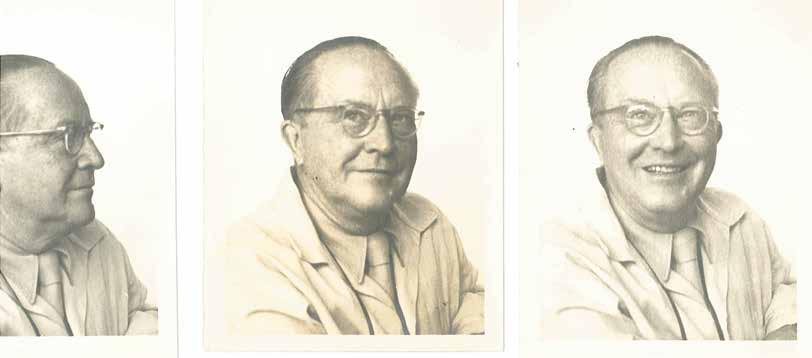
4 minute read
LEGENDARY PROFESSOR STARTED EDINBORO’S ART DEPARTMENT ON ITS CENTURY OF GROWTH
FROM THE BATTLEFIELD TO EDINBORO
Prohibition. The Harlem Renaissance. Women’s suffrage.
The Roaring Twenties yielded significant cultural and societal changes in the United States. At Edinboro University – then Edinboro State Normal School—the decade saw the arrival of talented artist Waldo Francis Bates Jr. and the dawn of a creative legacy.
Bates was born Nov. 1, 1889, in Scituate, Mass., to Waldo Sr. and Georgianna Howard Bates. He attended Massachusetts Normal Art School, now Massachusetts School of Art and Design, in Boston.
After completing his degree in 1912, he studied at the New England Conservatory of Music, where he met his future wife, Catherine; Harvard University; and, later, Penn State University.
In August 1917 – just four months after the United States entered WWI – Bates and other members of the Massachusetts National Guard were called to Camp Mills on Long Island, N.Y., to train for rapid deployment to France. They joined National Guard units from 26 states and the District of Columbia, forming the 42nd Infantry Division and fulfilling Maj. Douglas MacArthur’s vision to expeditiously assemble 27,000 troops.
The division was dubbed the Rainbow Division based on MacArthur’s comments that it would stretch across the U.S. “like a rainbow.”
Prior to deployment, Bates designed a distinctive shoulder patch insignia that each troop wore. It featured a half-arc rainbow of primary colors, a version of which is still worn today by the 42nd Infantry Division. Toward the end of WWI, soldiers modified the patch to a quarter arc in memory of the division’s more than 50% casualties during the war.
Art100
In 1920, the Pennsylvania Board of State Normal Schools Principals divided each of the 14 normal schools into specialized service areas, assigning Edinboro the elementary education and art areas. Bates was recruited to Edinboro that year to establish the art department and develop the curriculum.
At the beginning of the first year, there was only one student in the department, but all students were required to take a course in normal art. Bates taught blackboard drawing, emphasizing the importance of communicating key concepts using “chalk talk.” He set a high standard for the department and worked diligently to help it grow.
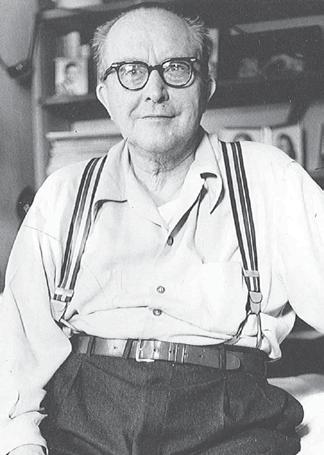
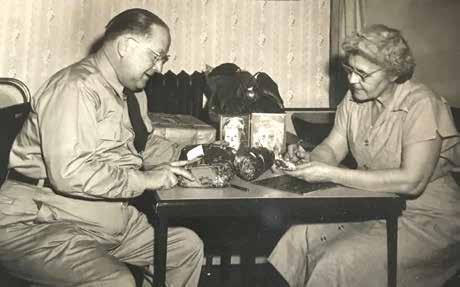
In 1923, Bates founded the ScaRAb Club, an organization aimed at promoting fraternal understanding and harmony among art students. The members frequently dressed in Egyptian costumes and hosted Egyptian-themed activities. Named after the sacred beetle of ancient Egypt, ScaRAb Clubs were forming around the world following the discovery of Tutankhamun’s tomb.
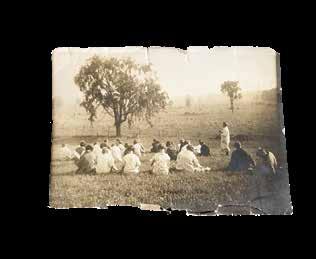
That same year, he recruited Aime Doucette, who also held a degree from Massachusetts School of Art, to join the faculty. Through their efforts, the art education program was expanded to include professional visual arts training.
Bates was recruited by the Metropolitan Museum of Art in New York City in 1924. He declined the offer, electing to stay in Edinboro and finish what he started. By 1925, 45 students were enrolled in the program, and within the next six years, enrollment grew to 115.
A beloved professor, Bates was fondly known by both students and fellow faculty members as “Pop.” He and Catherine regularly invited students to their house on the corner of High and East Normal streets for Sunday dinner – even during the Great Depression, feeding them fresh food from their garden. The 1941 yearbook states that he was the only professor to serve tea in his classroom.
In addition to art, Bates was a talented musician and an active participant in the Edinboro chorus and local church choir groups. His hobbies included beekeeping, philately and genealogy. He was a member of the Society of Mayflower Descendants and the Kinsmen of Presidents, by virtue of his relationship to Abraham Lincoln. His daughters, Frances and Edith, both attended Edinboro and went on to be teachers in California. Well-known in the community, Bates was responsible for taking author Virginia Sorensen to the sugar shack that inspired the 1956 Newbery Medal-winning novel, “Miracles on Maple Hill.”
In 1954, Bates suffered a heart attack and retired from the Art Department after 34 years at the helm. He passed away two years later, but his enormous legacy lives on through Edinboro’s thriving Art Department and the countless artists who have exhibited in his namesake gallery.
Information for this story was provided in part by AnneMarie Sundean, Janet Woods and Hurry Hill Maple Farm and Museum. Photos used courtesy of Catherine Young Boverio, granddaughter of Waldo F. Bates Jr.
1972
Waldo F. Bates Jr. begins his tenure as dean of the Art Department.
Bates founds the ScaRAb Club, a group aimed at promoting harmony among art students. Aime Doucette joins the Art Department faculty.
The number of art students grows to 45.
Henrietta M. Kuhn is among the first to graduate from the 4-year program.
Enrollment reaches more than 100 art students.
Loveland Hall, bearing the name of former trustee Francis A. Loveland, is dedicated, and Bates Gallery opens. Delta Phi Delta, a professional honor art fraternity, is founded.
Work is completed on 11 large murals in Normal Hall. Under the direction of Alfred J. Haller, student-artists spent more than two years designing and painting the murals. Enrollment decreases to 58 due to the Great Depression.
Gutzon Borglum, the sculptor of Mount Rushmore, is the honored guest at a dinner held by Delta Phi Delta. There are 90 art majors.
Doucette meets the demands of career-minded war veterans by launching a degree program in commercial art.
Ralph Bruce joins the faculty. East Hall is purchased from U.S. Army Keystone Ordnance Works near Meadville, Pa., and moved to campus.
George E. Hamilton Library is built.
Delta Phi Delta disbands.
Normal Hall burns and murals are destroyed.
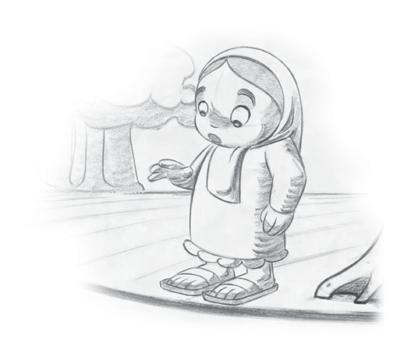
The BFA program begins.
Doucette Hall, named after Aime Doucette, is built. The gallery is named Bruce Gallery and dedicated to the memory of Ralph Bruce, who started the gallery and permanent collection.
Baron-Forness Library opens. Hamilton Library becomes Hamilton Hall and houses the School of Arts and Humanities and Nursing Division.
The MFA program is approved by the Department of Education.
Fire destroys East Hall. Lightning is the suspected cause.
East Hall is rebuilt to meet the needs of the University’s ceramics and sculpture students.
Edinboro University celebrates 100 years of art with a yearlong celebration.









